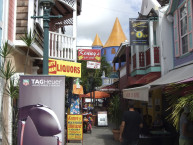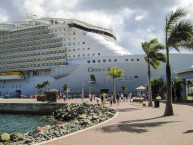Turks and Caicos
- Providenciales
- Grand Turk
- South Caicos
- East Caicos
- Middle Caicos
- North Caicos
- West Caicos
- Salt Cay
- Travel Insurance
 The beautiful Turks and Caicos Islands are situated 575 miles southeast of Miami and 39 miles south east of Mayaguana in the Bahamas. Covering 193 square miles of the Atlantic ocean, Turks and Caicos Islands has one of the longest coral reefs in the world, making it a premier diving destination.
The beautiful Turks and Caicos Islands are situated 575 miles southeast of Miami and 39 miles south east of Mayaguana in the Bahamas. Covering 193 square miles of the Atlantic ocean, Turks and Caicos Islands has one of the longest coral reefs in the world, making it a premier diving destination.
One of the most valuable possessions of the islands are the white sandy beaches, which in total cover 230 miles and are complimented with crystal clear waters. The islands are relatively flat but depending on the island, the terrain can vary from sand dunes to lush green vegetation. There are eight major islands: Salt Cay, Grand Turk, South Caicos, East Caicos, Middle Caicos, North Caicos, Providenciales and West Caicos.. The people on the islands are known for their friendliness. East Caicos and West Caicos are uninhabited.
The Tourism industry gives Turks and Caicos its main revenue. In addition to this the islands are also a major offshore financial center. There is a small traditional fishing industry that continues throughout Turks and Caicos. On the islands of Providenciales and Grand Turk you will find International style hotel accommodations, each one has its own unique set up and surroundings. Native dishes are served along with international cuisine, you will find this at most of the restaurants . More casual and serene accommodations can be found on the other islands and smaller cays.
The People
The English speaking population of 19,500 are dispersed over the eight main islands, the native people are descendants from African slaves who were originally brought over to grow cotton on the island of Providenciales. The natives are very kind and friendly people and are also very religious. The “expat” community of British, American, French, Canadian and Scandinavian gives the islands some European influence. The people of the islands have a very relaxed attitude that helps to create a perfect environment for you to unwind.
The islands are arrayed around the edges of two large limestone plateaus, the Turks Bank, with deep offshore waters that serve as major transit points for Humpback Whales, spotted Eagle rays, Manta Rays and Turtles. These same rich waters are used by anglers who are fishing for Tuna, Wahoo and Blue Marlin. Bordering the edges of the islands are lines of coral reef and some of the most impressive walls of coral in the Caribbean.
Wild Life
In the last decade on Turks and Caicos, divers have begun to discover some of the finest coral reefs and walls in the world. From the legendary walls of Grand Turk, West Caicos and Provo’s Northwest Point to the historic wrecks south of Salt Cay, a dozen world class walls have become Mecca for the serious diver.
begun to discover some of the finest coral reefs and walls in the world. From the legendary walls of Grand Turk, West Caicos and Provo’s Northwest Point to the historic wrecks south of Salt Cay, a dozen world class walls have become Mecca for the serious diver.
From late December through April, the entire Atlantic herd of 2,500 Humpback Whales pass through the shores on their annual migration to the Mouchoir Bank, just 20 – 30 miles southeast. During this period divers can listen to an underwater concert of the wale’s’ songs. During the summer, divers encounter Manta Rays cruising the face of the walls. Encounters with Dolphin are not uncommon.
The salt ponds and inland marshes serve as excellent feeding grounds for resident and migratory birds. Search for Great Blue Herons, Flamingos, osprey and Pelicans alongside Egrets, Terns, Frigates, Boobies and other water birds. As part of the National Parks system more than twelve small cays have been set aside and protected for breeding grounds.
On some of the less disturbed and smaller islands such as Little Water Cay or Great Sand Cay, it is the Turks island Iguana that dominates the land.
The Iguana is endangered and delicate but it thrives on these deserted islands, away from the influence of man. These islands are also protected by the National Parks system.
The National Parks were designed to protect the scenic environment and habitats, both to preserve and conserve them for future generations as well as make them available for public recreation.
In 1992 the government set aside 33 specific protected areas, a list that include nature reserves, sanctuaries and historical sites totaling more than 325 square miles. 210 square miles of this total amount are sensitive and ecologically essential wetlands ratified under the international Ramsar Bureau. Other protected areas include marine replenishment areas as well as breeding grounds for turtles, seabirds and other creatures. A marine mooring buoy system is just one of the many projects currently underway.




